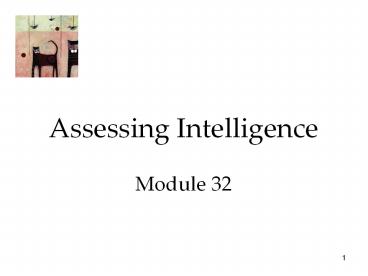Assessing Intelligence Module 32 - PowerPoint PPT Presentation
1 / 18
Title:
Assessing Intelligence Module 32
Description:
Intelligence testing is a method for assessing an mental skills and comparing ... Test-Retest Reliability: Using the same test on two occasions to measure consistency. ... – PowerPoint PPT presentation
Number of Views:18
Avg rating:3.0/5.0
Title: Assessing Intelligence Module 32
1
Assessing IntelligenceModule 32
2
Intelligence
- Assessing Intelligence
- The Origins of Intelligence Testing
- Modern Tests of Mental Abilities
- Principles of Test Construction
- The Dynamics of Intelligence
- Stability or Change?
- Extremes of Intelligence
3
Assessing Intelligence
Intelligence testing is a method for assessing an
mental skills and comparing them with others
using numerical scores.
4
Alfred Binet (1905)
and Simon started modern intelligence testing in
the Paris school system.
5
Lewis Terman
adapted Binets test and named the test the
Stanford-Binet Test. The formula of
Intelligence Quotient (IQ) introduced by William
Stern is
6
Aptitude and Achievement Tests
Aptitude tests are intended to predict your
ability to learn a new skill and achievement
tests are intended to reflect what you have
already learned.
7
The Wechsler Scales
- Age-related versions provide an overall IQ and
also yield both verbal and performance IQs. - (WPPSI-III) Wechsler Preschool and Primary Scale
of Intelligence-Revised. Ages 2 ½ to 7 years, 3
months - (WISC-IV) Wechsler Intelligence Scale for
Children-Revised. Ages 6 to 16 years, 11 months - (WAIS-III) Wechsler Adult Intelligence
Scale-Revised - Ages 16-89
8
(No Transcript)
9
Principles of Test Construction
For a psychological test to be acceptable it must
fulfill three criteria
- Standardization
- Reliability
- Validity
10
Standardization
Standardizing a test involves administering the
test to a representative sample of future test
takers in order to establish a basis for
meaningful comparison.
11
Normal Curve
Standardized tests establish a normal
distribution of scores on a tested population a
bell-shaped pattern called the normal curve.
12
Flynn Effect
In the past 60 years intelligence scores have
steadily risen by an average of 27 points a
phenomenon known as the Flynn effect.
13
Reliability
A test is reliable when it yields consistent
results. To establish reliability researchers
establish different procedures
- Split-half Reliability Dividing the test into
two equal halves and assessing how consistent the
scores are. - Reliability using different tests Using
different forms of the test to measure
consistency between them. - Test-Retest Reliability Using the same test on
two occasions to measure consistency.
14
Validity
Reliability of a test does not insure validity.
Validity of a test refers to what the test is
supposed to measure or predict.
- Content Validity Refers to the extent a test
measures a particular behavior or trait. - Predictive Validity Refers to the function of a
test in predicting a particular behavior or trait.
15
Stability or Change?
Intelligence scores become stable after about
seven years of age.
16
Extremes of Intelligence
The mentally retarded (IQ lt 70) and individuals
with high intelligence (IQ gt 135) are
significantly different.
17
Mental Retardation
18
High Intelligence
High-scoring people on intelligence
testscontrary to popular beliefstend to be
healthy, well adjusted, and unusually successful
academically.































